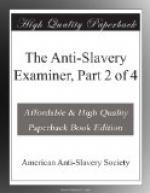The murdered young man had a mother and two sisters on the plantation, by whom he was dearly loved. When I told the old woman of what had befallen her son, she only said that it was better for poor John than to live in slavery.
Late in the fall of this year, a young man, who had already run away several times, was missing from his task. It was four days before we found him. The dogs drove him at last up a tree, where he was caught, and brought home. He was then fastened down to the ground by means of forked sticks of wood selected for the purpose, the longest fork being driven into the ground until the other closed down upon the neck, ancles, and wrists. The overseer then sent for two large cats belonging to the house. These he placed upon the naked shoulders of his victim, and dragged them suddenly by their tails downward. At first they did not scratch deeply. He then ordered me to strike them with a small stick after he had placed them once more upon the back of the sufferer. I did so; and the enraged animals extended their claws, and tore his back deeply and cruelly as they were dragged along it. He was then whipped and placed in the stocks, where he was kept for three days. On the third morning as I passed the stocks, I stopped to look at him. His head hung down over the chain which supported his neck. I spoke, but he did not answer. He was dead in the stocks! The overseer on seeing him seemed surprised, and, I thought, manifested some remorse. Four of the field hands took him out of the stocks and buried him: and every thing went on as usual.
It is not in my power to give a narrative of the daily occurrences on the plantation. The history of one day was that of all. The gloomy monotony of our slavery, was only broken by the overseer’s periodical fits of drunkenness, at which times neither life nor limb on the estate were secure from his caprice or violence.
In the spring of 1835, the overseer brought me a letter from my wife, written for her by her young mistress, Mr. Gateweed’s daughter. He read it to me: it stated that herself and children were well—spoke of her sad and heavy disappointment in consequence of my not returning with my master; and of her having been told by him that I should come back the next fall.
Hope for a moment lightened my heart; and I indulged the idea of once more returning to the bosom of my family. But I recollected that my master had already cruelly deceived me; and despair again took hold on me.




